
S3m Headphones
Owner's Manual
3502 Woodview Trace
Indianapolis, IN 46268
1-800-KLIPSCH • klipsch.com
Controls may vary by device.
COMPATIBILITY
Apple
®
, BlackBerry
®
, Windows, and Android
™
Devices.
Additional functionality when used with Klipsch Control for Android.
Hold
Indicator
Lines
Align indicator lines on the ear tip
and headphone nozzle for proper seal
English
German
Important Safety InformatIon
1)
READ these instructions.
2)
KEEP these instructions.
3)
HEED all warnings.
4)
FOLLOW all these instructions.
5)
DO NOT use this apparatus near water or moisture.
6)
If you hear ringing or experience pain or discomfort in your ears during or after
using any in-ear audio product, that is a sign you are listening too loud. When your
ears are exposed to high volumes (in excess of 85dB) for over an hour, you may be
permanently damaging your hearing.
7)
Turn down your listening device’s volume to zero before you insert the Klipsch
headphones and turn on the device. Once you have the headphones on, gradually
increase the volume to a comfortable, moderate volume.
8)
Do not install near any heat sources such as radiators, heat registers, stoves, or
other apparatus (including amplifiers) that produce heat.
9)
ONLY USE attachments/accessories specified by the manufacturer.
10)
REFER all servicing to qualified service personnel. Servicing is required when
the apparatus has been damaged in any way, such as power-supply cord or plug
is damaged, liquid has been spilled or objects have fallen into the apparatus, the
apparatus has been exposed to rain or moisture, does not operate normally, or
has been dropped
11)
NEVER operate a motor vehicle while listening to or wearing your headphones.
Not only dangerous, it is illegal in many places.
12)
NEVER operate heavy machinery while listening to or wearing your headphones.
13)
We don’t recommend you use the headphones while riding a bicycle, running,or
walking in heavy traffic areas.
WARNING:
Except in case of emergency, Klipsch recommends you do not use these headphones
or headsets (headphones plus microphone) as aviation communication equipment as
they are not engineered for many environmental conditions common in commercial
or non-commercial aircraft (including, but not limited to: altitude, temperature, noise
conditions, unpressurized aircraft, etc.) resulting in possible interference to critical
communications.
The Occupational Safety Health Administration (OSHA) has issued headphone usage
recommendations for maximum daily exposure and sound pressure levels (measured
in decibels (dB)). A decibel is a unit of measure of sound, and decibels increase
exponentially as sound gets louder. For example, conversational speech is typically
around 60dB, and a rock concert in a stadium is often about 110dB.
oSHa GuIdelIneS for noISe expoSure lImItS
EU COMPLIANCE INFORMATION
Eligible to bear the CE mark; Conforms to European Union Low Voltage Directive
2006/95/EC; European Union EMC Directive 2004/108/EC; European Union RoHS
Directive 2002/95/EC; European Union WEEE Directive 2002/96/EC; European Union
Registration, Evaluation, Authorization and Restriction of Chemicals (REACH) Directive
2006/121/EC.
WEEE NOTICE
Note: This mark applies only to countries within the European Union (EU) and Norway.
This appliance is labeled in accordance with European Directive 2002/96/
EC concerning waste electrical and electronic equipment (WEEE). This
label indicates that this product should not be disposed of with household
waste. It should be deposited at an appropriate facility to enable recovery
and recycling.
Sound Pressure Level Recommended Maximum Exposure
Per Day
90dB 8 Hours
92dB 6 Hours
95dB 4 Hours
97dB 3 Hours
100dB 2 Hours
102dB 1.5 Hours
105dB 1 Hours
110dB 30 Minutes
115dB 15 Minutes or less
120dB Avoid as damage may occur
FCC AND CANADA EMC COMPLIANCE INFORMATION
NOTE: This equipment has been tested and found to comply with the limits for a Class B
digital device, pursuant to part 15 of the FCC Rules. These limits are designed to provide
reasonable protection against harmful interference in a residential installation. This
equipment generates, uses and can radiate radio frequency energy and, if not in-stalled
and used in accordance with the instructions, may cause harmful interference to radio
communications. However, there is no guarantee that interference will not occur in a
particular installation. If this equipment does cause harmful interference to radio or
television reception, which can be determined by turning the equipment off and on, the
user is encouraged to try to correct the interference by one or more of the following
measures:
•
Reorient or relocate the receiving antenna.
•
Increase the separation between the equipment and receiver.
•
Connect the equipment into an outlet on a circuit different from that to which the
receiver is connected.
•
Consult the dealer or an experienced radio/TV technician for help.
Approved under the verification provision of FCC Part 15 as a Class B Digital Device.
Caution: Changes or modifications not expressly approved by the manufacturer could
void the user’s authority to operate this device.
This Class B digital apparatus complies with Canadian ICES-003.
Cet appareil numérique de la classe B est conforme à la norme NMB-003 du Canada.
PRODUCT REGISTRATION
Register your product online at www.klipsch.com/register
• Klipsch will keep you up-to-date on new products and promotions.
• Your personal information will never be resold.
• This registration information is not used for warranty purposes.
Please retain your receipt for warranty claims.
©2013, Klipsch Group, Inc. is a wholly-owned subsidiary of Voxx International
Corporation. Klipsch, Image and S4A are trademarks of Klipsch Group Inc., registered
in the U.S. and other countries.
Your phone's basic music app may not communicate with the Klipsch Control app. To
enjoy the full benefit of your S3m's control functions, you should download a free music
app from the Android Market.
Some funtions may vary on your device due to overriding system functions. Limited
functionality when not used with Klipsch Control app or on non-Android devices.
Apple is a trademark of Apple Inc. Android is a trademark of Google Inc. Google Play
is a trademark of Google Inc. The Trademark BlackBerry® is owned by Research In
Motion Limited and is registered in the United States and may be pending or registered
in other countries. Klipsch Group, Inc. is not endorsed, sponsored, affiliated with
or otherwise authorized by Research In Motion Limited. Windows is a registered
trademark of Microsoft Corporation in the United States and other countries.
Wichtige Sicherheitshinweise
1)
LESEN Sie diese Anweisungen durch.
2)
BEHALTEN Sie diese Anweisungen.
3)
BEACHTEN Sie alle Warnhinweise.
4)
FOLGEN Sie allen Anleitungen.
5)
Verwenden Sie diese Geräte NICHT in der Nähe von Wasser.
6)
Wenn Sie während oder nach der Verwendung eines im Ohr getragenen Audioprodukts
ein Klingeln hören oder Schmerzen im Ohr verspüren, zeigt das, dass Sie mit zu hoher
Lautstärke hören. Wenn Ihre Ohren über eine Stunde lang hohen Lautstärkepegeln
(über 85 dB) ausgesetzt sind, kann dies zu permanenten Hörschäden führen.
7)
Drehen Sie die Lautstärke Ihres Geräts auf Null, bevor Sie den Klipsch-Kopfhörer
einstecken und das Gerät einschalten. Sobald Sie den Kopfhörer aufgesetzt
haben, drehen Sie die Lautstärke langsam höher, bis Sie eine angenehme, nicht zu
hohe Lautstärke erreicht haben.
8)
Installieren Sie sie nicht in der Nähe von Wärmequellen wie Heizkörpern,
Warmlufteintrittsöffnungen, Öfen oder anderen wärmeerzeugenden Geräten
(einschließlich Verstärkern).
9)
Verwenden Sie AUSSCHLIESSLICH vom Hersteller empfohlene Zusatzgeräte/Zubehör.
10)
Lassen Sie ALLE Wartungen von geschulten Kundendiensttechnikern durchführen.
Eine Wartung ist nötig, wenn das Gerät auf irgendeine Weise beschädigt wurde, z.
B. durch Schäden am Netzkabel oder -stecker, durch Verschütten von Flüssigkeiten,
durch das Hineinfallen von Objekten, durch Regen oder Feuchtigkeit, wenn es nicht
richtig funktioniert oder wenn es fallengelassen wurde.
11)
Fahren Sie NIE ein Kraftfahrzeug, während Sie den Kopfhörer verwenden. Das ist
nicht nur gefährlich, sondern vielerorts auch illegal.
12)
Bedienen Sie NIE schwere Maschinen, während Sie den Kopfhörer verwenden.
13)
Wir empfehlen, den Kopfhörer nicht beim Radfahren, Joggen oder beim Gehen in
Bereichen mit hohem Verkehr zu verwenden.
WARNUNG:
Mit Ausnahme von Notfällen empfiehlt Klipsch, diese Kopfhörer oder Headsets (Kopfhörer
plus Mikrofon) nicht in Kommunikationssystemen in Flugzeugen zu verwenden, da sie nicht
auf die in kommerziellen und nicht-kommerziellen Flugzeugen auftretenden vielfältigen
Umweltbedingungen ausgelegt sind. Hierzu gehören unter anderem: Höhe, Temperatur,
Lärmbedingungen, nicht unter Druck stehende Flugzeuge etc., was zu Interferenzen bei
wichtigen Meldungen führen kann.
Die US-Behörde Occupational Safety Health Administration (OSHA) hat Richtlinien
bezüglich der täglichen Verwendungszeiten und der Schalldruckpegel (in
Dezibel – dB) bei der Nutzung von Kopfhörern herausgegeben. Ein Dezibel ist eine
Lautstärkemaßeinheit, und die Einheiten nehmen bei steigender Lautstärke exponentiell
zu. Beispielsweise ist ein typisches Gespräch etwa 60 dB laut, ein Rock-Konzert in einem
Stadium hingegen oft um die 110 dB.
OSHA-RICHTLINIEN FÜR LÄRM-IMMISSIONSGRENZWERTE
EINHALTUNG VON EU-RICHTLINIEN
Darf das CE-Zeichen führen. Entspricht der EU-Niederspannungsrichtlinie 2006/95/EC;
EU-Richtlinie 2004/108/EC (Elektromagnetische Verträglichkeit); EU RoHS-Richtlinie
2002/95/EC; EU-Richtlinie über Elektro- und Elektronik-Altgeräte (WEEE) 2002/96/EC;
EU-Verordnung zur Registrierung, Bewertung, Zulassung und Beschränkung chemischer
Stoffe (REACH) 2006/121/EC.
WEEE-HINWEIS
Hinweis: Dieses Zeichen gilt nur für Länder innerhalb der europäischen Union (EU) und
Norwegen.
Dieses Gerät ist entsprechend der europäischen Richtlinie 2002/96/
EC über Elektro- und Elektronik-Altgeräte (WEEE) ausgezeichnet.
Dieses Etikett zeigt an, dass das Produkt nicht mit dem Hausmüll
entsorgt werden darf. Es sollte an einer dafür vorgesehenen Einrichtung
abgeliefert werden, um Wiederverwendung und Recycling zu ermöglichen.
PRODUKTREGISTRIERUNG
Registrieren Sie Ihr Produkt online unter www.klipsch.com/register
• Klipsch wird Sie über neue Produkte und Sonderangebote informieren.
• Ihre personenbezogenen Daten werden nie verkauft.
• Diese Registrierungsdaten werden nicht zu Garantiezwecken verwendet.
Bewahren Sie bitte Ihre Quittung auf, um die Garantie in Anspruch nehmen zu
können.
Schalldruckpegel und empfohlene maximale Nutzungsdauer Pro Tag
90dB 8 Stunden
92dB 6 Stunden
95dB 4 Stunden
97dB 3 Stunden
100dB 2 Stunden
102dB 1.5 Stunden
105dB 1 Stunden
110dB 30 Minuten
115dB Maximal 15 Minuten
120dB
Zu vermeiden, da Hörschäden
auftreten können


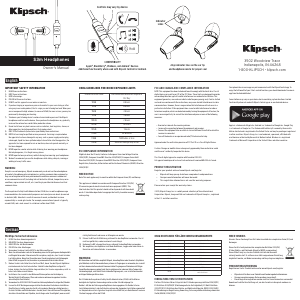

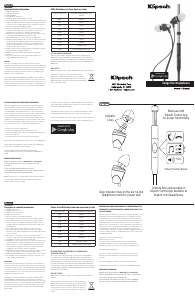
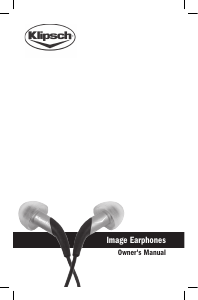
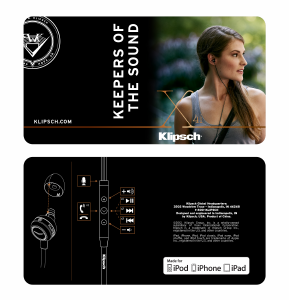
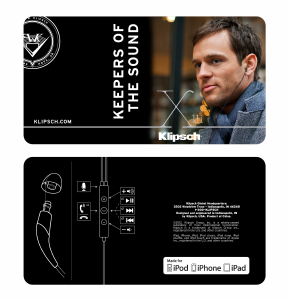
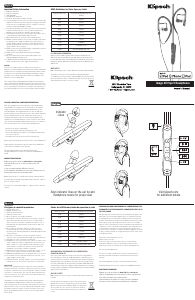
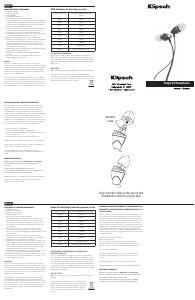
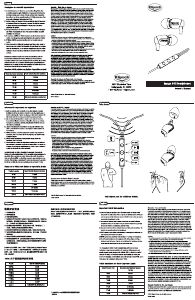
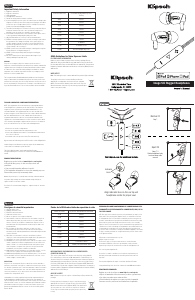
Joignez-vous à la conversation sur ce produit
Ici, vous pouvez partager ce que vous pensez du Klipsch S3m Casque. Si vous avez une question, lisez d’abord attentivement le mode d’emploi. La demande d’un mode d’emploi peut être effectuée en utilisant notre formulaire de contact.